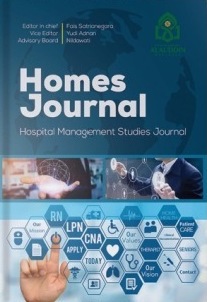FACTORS ASSOCIATED WITH DHEALTH HOSPITAL MANAGEMENT SYSTEM
Abstract
Background: Delivering electronic medical records and health transformation, RSUD Labuang Baji implemented the Dhealth Hospital Management Information System (SIMRS). However, this SIMRS has obstacles in terms of human, organization, and technology.
Objective: To analyze the relationship of human, organizational, and technological components with the benefits of SIMRS Dhealth at RSUD Labuang Baji.
Methods: Quantitative research with a cross sectional study design. The sample was 221 health workers using SIMRS DHealth at Labuang Baji Hospital. Data collection using a questionnaire.
Results: System use, user satisfaction, organizational structure, top management support, IT staff capabilities, system quality, information quality, and service quality have a positive relationship with the benefits of SIMRS Dhealth at Labuang Baji Hospital.
Conclusion: Users need to routinely use SIMRS. RSUD Labuang Baji needs to improve the network and add IT staff. The SIMRS developer needs to simplify features, improve the system, and provide instructions for use.
References
Anwar, K., Fikry Aransyah, M., Ibrahim, S. N., Nurlita, F., Sari, A. S., & Marlinda, N. (2023). Literature review: Assessing the success factors of Hospital Management Information System (HMIS) implementation using the HOT-FIT method in Indonesia. New Applied Studies in Management, 6(2), 26–38.
Aprilianingsih, M., Listina, F., & Kayrus, A. (2022). Evaluasi Sistem Informasi Manajemen Rumah Sakit (SIMRS) pada Bagian Pendaftaran Rawat Jalan dengan Metode Hot-Fit di RS Swasta di MetroTahun 2022. Jurnal Formil (Forum Ilmiah) KesMas Respati, 7(3), 262–273. https://doi.org/https://doi.org/10.35842/formil.v7i3.450
Aviat. (2023, October 1). 22% Rumah Sakit Belum Menerapkan Aplikasi SIMRS. Karya Prima Putera Perkasa. https://aviat.id/22-rumah-sakit-belum-menerapkan-aplikasi-simrs/
Cholik, C. A. (2021). Perkembangan Teknologi Informasi Komunikasi/ ICT Dalam Berbagai Bidang. Jurnal Fakultas Teknik, 2(2), 39–46. https://jurnal.unisa.ac.id/index.php/jft/article/view/83
Daerina, S. R. F., Mursityo, Y. T., & Rokhmawati, R. I. (2018). Evaluasi Peranan Persepsi Kegunaan dan Sikap Terhadap Penerimaan Sistem Informasi Manajemen Rumah Sakit (SIMRS) di Rumah Sakit Daerah Kalisat (Vol. 2, Issue 11). http://j-ptiik.ub.ac.id
DeLone, W. H., & McLean, E. R. (2003). The DeLone and McLean Model of Information Systems Success: A ten-year update. Journal of Management Information Systems, 19(4), 9–30. https://doi.org/10.1080/07421222.2003.11045748
Dewi, W. S., Ginting, D., & Gultom, R. (2021). Evaluasi Sistem Informasi Manajemen Rumah Sakit Di Instalasi Rekam Medis RSUP H. Adam Malik Dengan Metode Human Organization Technology Fit (HOT-FIT) Tahun 2019 (Vol. 6, Issue 1). Online. http://jurnal.uimedan.ac.id/index.php/JIPIKI73Journalhomepage:http://jurnal.uimedan.ac.id/index.php/JIPIKI
Gultom, A., Rumengan, G., & Trigono, A. (2023). Implementasi Sistem Informasi Manajemen Rumah Sakit Terhadap Kinerja Pelayanan Kesehatan Di Rumah Sakit Umum Universitas Kristen Indonesia Jakarta Tahun 2023. Jurnal Manajemen Dan Administrasi Rumah Sakit Indonesia (MARSI), 7(3), 227–235.
Hasanah, S., Widiyanto, W. W., & Wulandari, S. (2022). Pengaruh Human, Organization and Technology Terhadap Manfaat SIMRS Di RSU Asy-Syifa‟ Sambi.”. Journal Health Information Management Indonesian (JHIMI), 1(2), 24–30. https://doi.org/https://doi.org/10.46808/jhimi.v2i1.24
Indrayati, L., Bahry Noor, N., Rivai, F., & Muhammad Saleh, L. (2021). Factors Affecting User Satisfaction and Benefits of SIMRS at the Regional General Hospital Beriman. Turkish Journal of Computer and Mathematics Education, 12(13), 1565–1572. https://doi.org/https://doi.org/10.17762/turcomat.v12i13.8786
Kaufhold, M. A., Bayer, M., & Reuter, C. (2020). Rapid Relevance Classification of Social Media Posts in Disasters and Emergencies: A System and Evaluation Featuring Active, Incremental and Online Learning. Information Processing & Management, 57(1), 102132. https://doi.org/https://doi.org/10.1016/j.ipm.2019.102132
Kementerian Kesehatan Republik Indonesia. (2020). Kebijakan Digitalisasi di Rumah Sakit. https://persi.or.id/wp-content/uploads/2020/07/materi_drandi_web160720.pdf
Khotimah, A., & Lazuardi, L. (2020). Evaluasi Sistem Informasi Manajemen Rumah Sakit Rajawali Citra Yogyakarta Menggunakan Model Human Organization Technology Fit (HOT-Fit). Jurnal Sistem Informasi Kesehatan Masyarakat Journal of Information Systems for Public Health, 5(1), 19–26. https://doi.org/https://doi.org/10.22146/jisph.26280
Menteri Kesehatan Republik Indonesia. (2014). Peraturan Menteri Kesehatan Republik Indonesia Nomor 82 Tahun 2013 Tentang Sistem Informasi Manajemen Rumah Sakit. https://www.kemhan.go.id/itjen/wp-content/uploads/2017/03/bn87-2014.pdf
Menteri Kesehatan Republik Indonesia. (2022). Peraturan Menteri Kesehatan Republik Indonesia Nomor 24 Tahun 2022 Tentang Rekam Medis. https://peraturan.bpk.go.id/Details/245544/permenkes-no-24-tahun-2022
Nastiti, I., & Santoso, D. B. (2022). Evaluasi Penerapan Sistem Informasi Manajemen Rumah Sakit di RSUD SLG Kediri dengan Menggunakan Metode HOT-Fit. Jurnal Kesehatan Vokasional, 7(2), 85. https://doi.org/10.22146/jkesvo.72357
Nasution, S. W., Chairunnisa, & Ginting, C. N. (2023). Hospital Management Information System Implementation Assessment Using HOT-FIT Model in Langsa General Hospital Aceh, Indonesia. 55(1), 13–20. https://doi.org/10.15395/mkb.v55n1.2808
Nathan, B. S. R., Apigian, C. H., Nathan, T. S. R., & Tu, Q. (2004). A Path Analytic Study of the Effect of Top Management Support for Information Systems Performance. Omega; The International Journal of Management Science, 32(6), 459–471. https://doi.org/10.1016/j.omega.2004.03.001
Pertiwi, D., Sejati, F. R., & Prasetianingrum, S. (2020). Analisis Kesuksesan Sistem E-Commerce Yang Berpartisipasi Pada Harbolnas Dengan Menggunakan Model Delone & Mclean. JIMFE (Jurnal Ilmiah Manajemen Fakultas Ekonomi), 6(2), 237–252. https://doi.org/10.34203/jimfe.v6i2.2610
Presiden Republik Indonesia. (2023). Undang-Undang Republik Indonesia Nomor 17 Tahun 2023 Tentang Kesehatan. https://peraturan.bpk.go.id/Details/258028/uu-no-17-tahun-2023
Rumah Sakit Umum Daerah Labuang Baji. (2022). Laporan Survei Kepuasan Masyarakat Tahun 2022. https://drive.google.com/file/d/1sMCQNhbji-6qFg1awFprD4I6sreJLnSt/view
Saputra, M. G., Munaa, N., Anggraini, Y., Ummah, F., Rahmawati, N. V., Kusdiyana, A., & Nuryati. (2023). Evaluasi Implementasi Sistem Informasi Manajemen Rumah Sakit dengan Metode HOT-Fit di RSU Muhammadiyah Babat. J-REMI : Jurnal Rekam Medik Dan Informasi Kesehatan, 4(4), 248–256. https://doi.org/10.25047/j-remi.v4i4.4047
Simorangkir, A. D., Supriyantoro, & Arrozi. (2020). The Implementation of Hospital Management Information Systems Using Human, Organization, Technology, And Benefit Models at Dinda Hospital Tangerang. Jurnal of Multidisciplinary Academic, 4(6), 387–391.
Susilo, B. B. B., & Mustofa, K. (2019). Evaluasi Penerapan Sistem Informasi Manajemen Rumah Sakit (SIMRS) di RSUD Praya Kabupaten Lombok Tengah Nusa Tenggara Barat. Jurnal Sistem Informasi Kesehatan Masyarakat Journal of Information Systems for Public Health, 4(1), 1–14. https://doi.org/https://doi.org/10.22146/jisph.41428
Wijoyo, A., Yusuf, M., Putra, D. E. B., Febrian, M. A., Apriansyah, M. D., & Ilham, M. (2023). Peran Sistem Informasi Manajemen Organisasi Dalam Pengambilan Keputusan Berbasis Komputer di Rumah Sakit. JORAPI : Journal of Research and Publication Innovation, 1(1), 108–115.
Wixom, B. H., & Watson, H. J. (2001). An Empirical Investigation of the Factors Affecting Data Warehousing Success. MIS Quarterly, 25(1), 17–41.
Yusof, M. M., Kuljis, J., Papazafeiropoulou, A., & Stergioulas, L. K. (2008). An evaluation framework for Health Information Systems: human, organization and technology-fit factors (HOT-fit. International Journal of Medical Informatics, 77(6), 377–385. https://doi.org/10.1016/j.ijmedinf.2007.08.004


